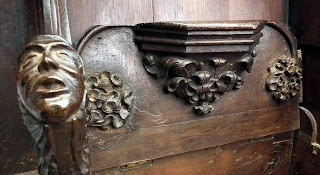
Medieval church services were extremely tiring, as prayers were recited standing up with arms uplifted. For elderly or infirm priests, the strain could be unbearable.
 To help them cope, the carpenters who made the stalls where they sat designed tip-up chairs with a ledge underneath, so they could take the weight off their feet. They were called misericords, from the Latin misericordia, or 'pity of the heart'.
To help them cope, the carpenters who made the stalls where they sat designed tip-up chairs with a ledge underneath, so they could take the weight off their feet. They were called misericords, from the Latin misericordia, or 'pity of the heart'.
Stalls containing misericords have high backs and wings intended to keep the draughts off the priest. The arms have prominent bosses intended to help the priest get to his feet.
The seat of a misericord has a carved brace in the middle under the ledge and a supporter on either side called an 'ear'.
Being located in the chancel, misericords are frequently ornately carved, but because they are invisible when in the down position and were also subject to the indignity of being sat on, the medieval craftsmen felt free to portray secular or even pagan subjects.
 The most ornate misericords appear in the most expensively-equipped churches, of course. St Mary's Hospital has a very fine set of misericords dating from the 13th century, and Chichester Cathedral's early 14th century misericords feature mermaids, musicians and a whole zoo of assorted animals.
But misericords crop up in parish churches too.
The most ornate misericords appear in the most expensively-equipped churches, of course. St Mary's Hospital has a very fine set of misericords dating from the 13th century, and Chichester Cathedral's early 14th century misericords feature mermaids, musicians and a whole zoo of assorted animals.
But misericords crop up in parish churches too.
East Lavant church has five, dating from the 15th century, featuring vigorous portraits of local worthies including a bishop. One of the ears is a lovely lizard.
West Wittering has two medieval misericords, one with a rather worm-eaten bishop, and two modern replacements.
 At West Tarring, most of the late medieval misericords are simple foliage, but two show an extraordinary head like a hippy, long-haired and bearded with a flower or ornament on his forehead.
At West Tarring, most of the late medieval misericords are simple foliage, but two show an extraordinary head like a hippy, long-haired and bearded with a flower or ornament on his forehead.
The misericords at Broadwater have some very nice armrest bosses carved with heads that seem to be shouting.